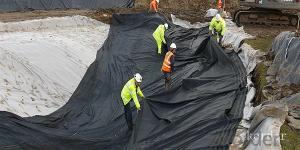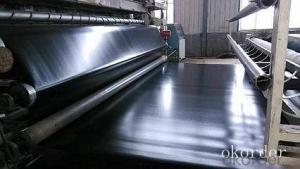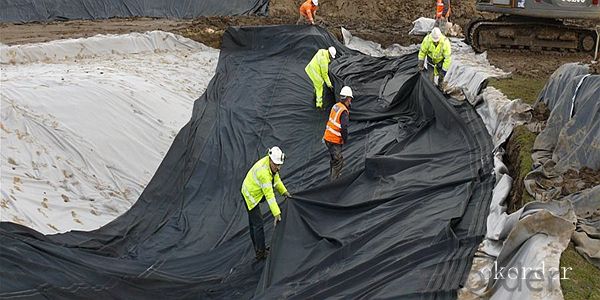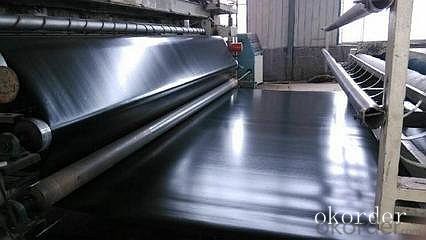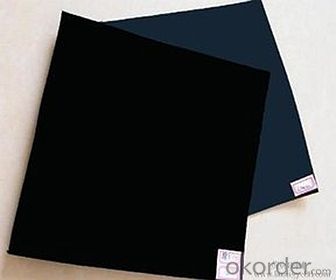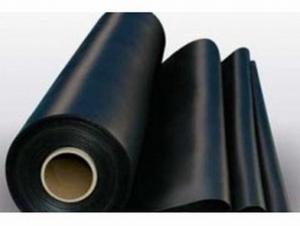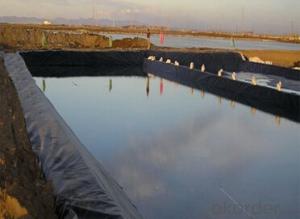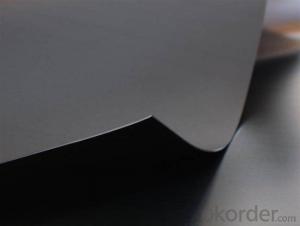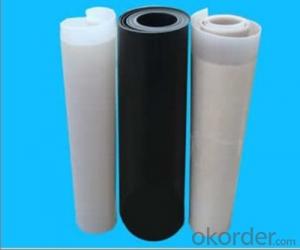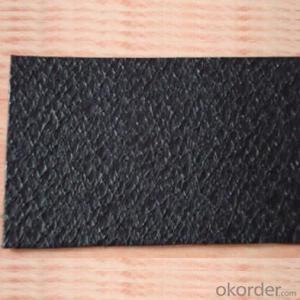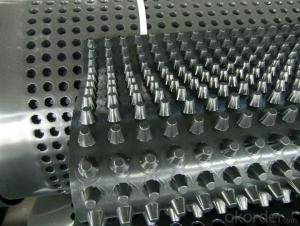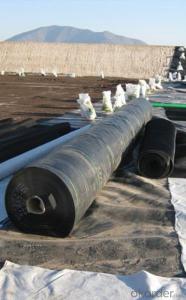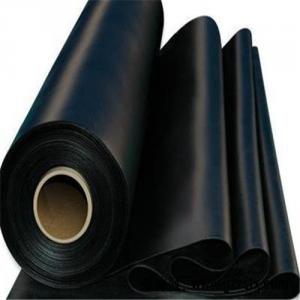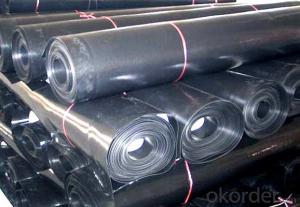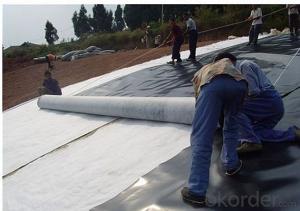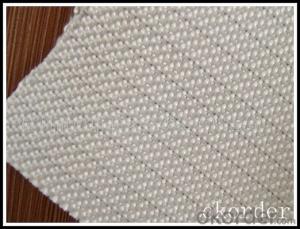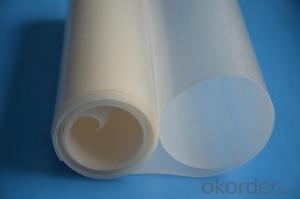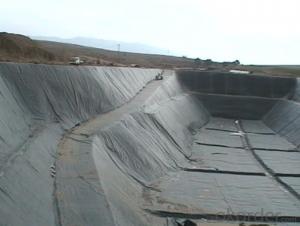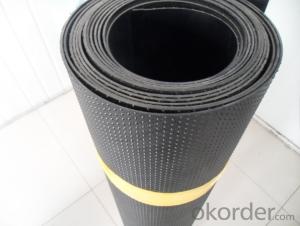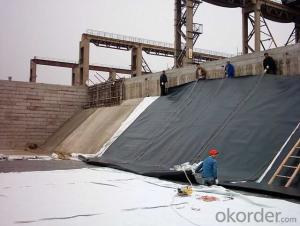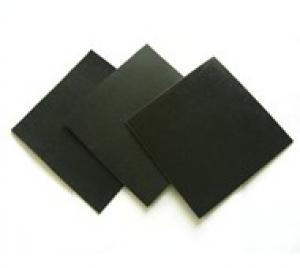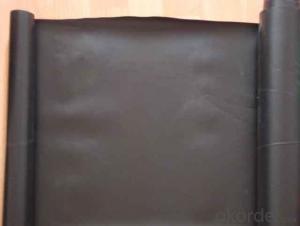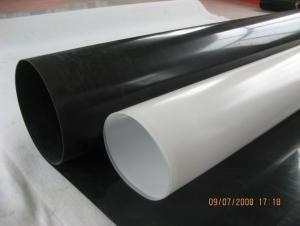HDPE Smooth Geomembrane for Linear Environmental Engineering as Waterproof Facing of Earth and Rockfill Dams
- Loading Port:
- China main port
- Payment Terms:
- TT OR LC
- Min Order Qty:
- 1000 m²
- Supply Capability:
- 1000000 m²/month
OKorder Service Pledge
OKorder Financial Service
You Might Also Like
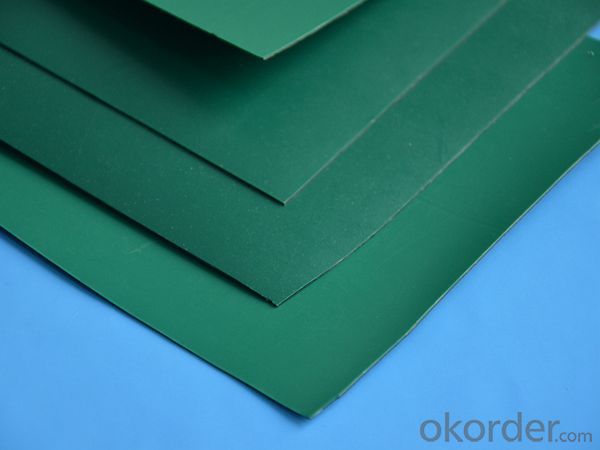
Product Introduction
Geomembrane with impermeable plastic film as a substrate, and non-woven geotextile composite made of impermeable material, which depends on the seepage properties of a impermeable plastic film performance.
Properties :
It is of excellent physical and hydraulic properties, and especially its advantanges in the tensile strength,longitudinal and lateral strength ratio,uniformity and so on.
Supply a wide range of color,such as white,green and grey.Independent developed soft green fiber can protect installer's eyes at the onsite during work under the strong light,and it is eco-friendly productions.
Application
1. Environmental protection, sanitation (such as solid waste landfills, sewage treatment plants, power plants Chi-conditioning, industrial, hospital solid waste, etc.) .
2. Water (such as rivers, lakes and reservoirs of the anti-dam, plugging, reinforcement of the canal seepage, the vertical wall of the heart, slope protection, etc.).
Our Service
1.On a regular basis or as per your request,we entrust national testing agencies to conduct quality inspections
2. Strictly in accordance with the ISO9001-2008 international quality system standard,we monitor and manage the whole process throughout production,quality testing,and measurement to ensure product quality
3. For quality-related construction delay or substandard construction(except for damage or losses due to customer’s responsibility or irresistible natural disasters),we have refunding,replacement,and repair services.We will respond to customers’ feedbacks on quality issues within 24 hours.
After-sales service
1.In order to provide customers with comprehensive technical support,we will provide technical and other related information upon request in a timely manner.
2.In required,we will appoint specialized technicians to the construction site to give technical trainings to construction people,and offer technical guidance throughout the whole construction process.
3.For damage due to shipment and delivery,after we receive the complaint,we will check the issure through provided pictures and videos.If our responsibility is confirmed,we wil offer free replacement.
4.When the construction is completed,as your request,our technical staff may participate in the final acceptance.
FAQ:
Q: What kind of payments does jenor support?
A: T/T, L/C, Cash are accepted.
Q: Do you charge for the samples?
A: Accordeing to our company policy, the samples are free, we only charge the freight fee. And we will return the freight fee during the next order.
Q: Can you produce according to customers' design?
A: Sure, we are professional manufacturer, OEM and ODM are both welcome.
Q: Do you have other products?
A: Yes, please check the pictures:
- Q: What is the hotfilm electric film?
- The hotfilm electrothermal?film is an electrical heating element to directly transfer the electrical energy into thermal energe. Just as the electrical?heated?tube, the electrical bar, the electric?hot?plate, the electric?heater, the electric?cooker, and the induction cooker, it is a component of the big family of the electrical products. But the difference is that the electric film is still a relatively new product in China. The application history of it is only a short period of a decade. And the application areas of it is far less extensive than other electric products. So people's knowledge and understanding has not been very populared.
- Q: What are the design considerations for geomembranes in floating covers?
- Design considerations for geomembranes in floating covers include: 1. Material selection: The choice of geomembrane material is crucial as it should be resistant to UV degradation, chemical exposure, punctures, and tear propagation. Common materials used include high-density polyethylene (HDPE) and polyvinyl chloride (PVC). 2. Thickness: The thickness of the geomembrane should be determined based on factors such as the type of liquid or gas to be contained, the expected loading conditions, and the desired lifespan of the floating cover. Thicker geomembranes provide better resistance to punctures and tears. 3. Welding technique: Proper welding of geomembrane panels is essential to ensure a watertight and airtight seal. Different welding techniques, such as heat fusion or extrusion welding, may be suitable depending on the geomembrane material and site conditions. 4. Anchoring system: Floating covers need to be securely anchored to prevent wind uplift, excessive movement, or damage from wave action. The design should consider appropriate anchoring methods, such as anchor trenches, weight plates, or cable systems, to maintain cover stability. 5. Slope considerations: The slope of the floating cover is crucial to facilitate proper rainwater runoff and prevent ponding, which can lead to additional stress on the geomembrane. A slope design that allows for efficient drainage and minimizes stress on the geomembrane is essential. 6. Temperature variations: Floating covers are exposed to temperature fluctuations, which can cause expansion and contraction of the geomembrane. Design considerations should account for thermal expansion and contraction to avoid excessive stress and potential failure. 7. Environmental factors: The design should consider the impact of environmental factors such as wind, rain, snow, and sunlight exposure. Proper consideration of these factors will help ensure the longevity and performance of the floating cover and the geomembrane. 8. Quality control and testing: Regular quality control checks and testing during the design and construction stages are essential to ensure the integrity and effectiveness of the geomembrane in floating covers. This may include testing for weld strength, leak detection, and overall geomembrane performance. Overall, the design considerations for geomembranes in floating covers involve selecting appropriate materials, ensuring proper welds and anchoring systems, considering slope and temperature variations, accounting for environmental factors, and conducting quality control measures to create a reliable and durable containment system.
- Q: Can geomembranes be used in reservoirs and dams?
- Yes, geomembranes can be used in reservoirs and dams. Geomembranes are impermeable liners that are designed to contain liquids or prevent seepage. They can be installed in reservoirs and dams to provide a barrier to prevent water leakage, enhance water storage capacity, and protect against erosion and contamination.
- Q: Can geomembranes be used in fish hatcheries and aquaponics systems?
- Yes, geomembranes can be used in fish hatcheries and aquaponics systems. Geomembranes are impermeable liners that are commonly used for lining ponds, tanks, and other containment systems. They can help prevent water leakage and maintain proper water levels, which is crucial for fish hatcheries and aquaponics systems. Additionally, geomembranes can also protect the underlying soil from contamination and help maintain water quality, making them suitable for these applications.
- Q: What is the purpose of a geomembrane?
- The purpose of a geomembrane is to provide a barrier or containment system for various substances and materials, such as liquids, gases, and solids, in order to prevent their migration or seepage into the surrounding environment. It is commonly used in construction, environmental, and industrial applications to ensure the integrity and protection of structures, landfills, ponds, and other containment areas.
- Q: how to brush wallpaper basilemma
- First diluted the basilemma with pure water, and then follow the basilemma: Water =1: 1.5 brushing two times, wallpaper basilemma is developed from water-based high-tech materials, harmless to the human body and environment without adverse volatile gases. compared with conventional oil-based alkyd varnish, it effectively protect the indoor environment, and the life of oil alkyd varnish is longer three to five times. Wherein the moisture-proof film is used elastic molecular materials, and it in the case of micro-cracks in the walls is effectively protect your walls.
- Q: Geogrid construction should refer to what norms
- At present, there is no special geogrid reinforced soil construction specifications, can refer to the "road reinforcement soil construction technical specifications" in the provision of the belt with the requirements to do.
- Q: What are the advantages of using geomembranes in agricultural irrigation systems?
- There are several advantages to using geomembranes in agricultural irrigation systems. Firstly, geomembranes act as a barrier to prevent water seepage, which helps in conserving water resources and reducing water wastage. Secondly, they also prevent the loss of nutrients and fertilizers by keeping them within the irrigation area, leading to more efficient and effective use of these resources. Additionally, geomembranes help in controlling weed growth, reducing the need for herbicides and manual labor. Lastly, these membranes are durable and resistant to degradation, providing a long-lasting solution for irrigation systems and reducing maintenance costs in the long run.
- Q: What is the working principle of electric heating film
- The electrothermal?film heating system is a kind of half-transparent polyester film which can heat after electrified, which is processed by conductive special ink, metal carrier flow strip, and hot pressing in the insulation polyester film. Using electrothermal?film as heating element, transforming heat into space in the form of radiation, so that the human body and the object will be warm first. Its comprehensive effect is better than that of the conventional heat radiator heating mode. The low temperature radiation electric heating film is composed of power supply, a temperature controller, a connecting piece, an insulating layer, an electric heating film and a facing layer. The power supply connect with an electric heating film through a conducting wire, and convert electric energy into heat energy. Because the electric heating film is a pure resistance circuit, so it has high conversion efficiency, Most energy is converted into heat energy in addition to a small amount of loss. Both sides of electrothermal membrane are insulating layer and finish?coat, among which insulating layer prevents heat energy from lossing in the other side and finish?coat, heated by electrothermal?film, provides heat to the room in the form of radiation. The working temperature of the electric heating film heating system is below 85 ℃. It provides heat to the room in the form of infrared ray Infrared ray produced by electrothermal film first heat the room (walls, floors), and then objects receiving the heat transfer it into air. Because the radiation heating distrubutes heat more evenly than radiator does, so surface temperature of room wall will rise, reducing the cold radiation on the human body from wall. So the temperature meets the need of human body and makes people comfortable.
- Q: Can all-purpose adhesive stick composite geomembrane?
- The best way to stick composite geomembrane is to weld with sweat soldering machine or monorail welding gun. If there is no such device on the construction site, you can brush PE adhesive, or use all-purpose adhesive. Brushing must be uniform, and sticking should be close and tight. Brushing surface must be kept clean without water or mud. Brushing all-purpose adhesive is relatively expensive.
Send your message to us
HDPE Smooth Geomembrane for Linear Environmental Engineering as Waterproof Facing of Earth and Rockfill Dams
- Loading Port:
- China main port
- Payment Terms:
- TT OR LC
- Min Order Qty:
- 1000 m²
- Supply Capability:
- 1000000 m²/month
OKorder Service Pledge
OKorder Financial Service
Similar products
Hot products
Hot Searches
Related keywords
